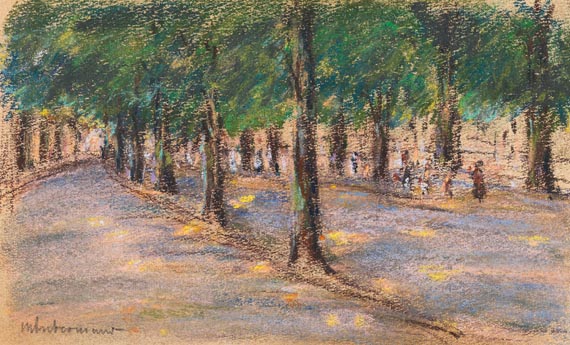
2
Max Liebermann
Allee, 1912.
Pastel
Estimate:
€ 18,000 / $ 19,260 Sold:
€ 43,920 / $ 46,994 (incl. surcharge)
Pastel
Signed lower left. On brownish hand-made cardboard. 10,7 x 17,6 cm (4,2 x 6,9 in), the full sheet
With collector's stamp JS (not in Lugt) on verso and with number "16.".
PROVENANCE: Private collection southern Germany.
Max Liebermann began capturing his immediate environment on paper at the age of nine. When the renowned Berlin painter Carl Steffeck saw drawings by the fifteen-year-old he recommended that the boy's talent should be encouraged as much as possible - much against his parents ideas. Steffeck gave Liebermann his first drawing lessons and encouraged him to attend the Weimar Akademie. Liebermann studied in Weimar for three years until 1872. A trip to Düsseldorf in 1871 took the young artist to Mihály Munkácsy, a Hungarian painter who lived here. Liebermann was inspired by Munkácsy's Realism. He spent the years 1873 to 1878 in Paris and the artist colony of Barbizon. Here he studied the art of Millet, whose paintings of farm workers had a strong influence on him. A first sojourn in Holland in 1871 was followed by regular trips to the Netherlands, where he discovered suitable motifs for his most important works. His striving to elevate the life and work of the simple man to the realms of art in an unpretentious simplicity was not generally accepted. Liebermann continually fought for acceptance. Only after turning towards motifs and scenes of bourgeois life did he become the celebrated and sought after painter of the liberal bourgeoisie of the turn of the century. He spent the years 1878 to 1884 in Munich and then returned to his native town Berlin in 1884. Liebermann was an important personality not only as an artist but also as an art politician. At the beginning of 1892 he was a member of the 'Erste Sezession Deutschland' (First German Secession), an organisation which he chaired in Berlin from 1898 to 1911. His home town honored Liebermann by appointing him professor at the Royal Academy of Arts.
The Berlin Tiergarten, located right infront of Liebermann’s door,was a happy coincidence and a rich source of inspiration for the artist, as this was where he could make his atmospheric pastels, alleys of trees suffused with light. Liebermann’s great mastery in coloring has its effect in particularly these plain motifs, as he can entirely focus on the play of colors created by the slopingly incident light, and integrate it into his composition. This is where a tradition that Liebermann carried over from the 19\up5 th century comes to show. It is a solidity of perspective, that refuses all modernism. but yet seems so original.
Later, from 1920 to 1932, he was the president of the Prussian Academy of Arts. Liebermann retreated from the political world in the last years of his life. He became severely ill in 1934 and died three months later in isolation in his Berlin apartment. [KD]
2
Max Liebermann
Allee, 1912.
Pastel
Estimate:
€ 18,000 / $ 19,260 Sold:
€ 43,920 / $ 46,994 (incl. surcharge)




 Lot 2
Lot 2 